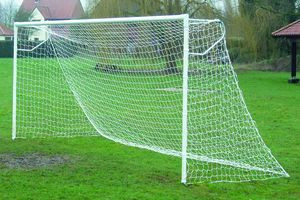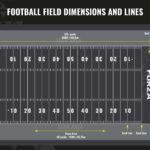[This article delves into the specific lines found on a football pitch, clarifying their functions and dimensions. At CAUHOI2025.UK.COM, we understand that navigating the rules of football can be complex. This detailed guide aims to simplify your understanding, whether you’re a player, coach, or avid fan, ensuring you grasp the significance of each line. Learn about pitch markings, field lines, and soccer field dimensions.]
1. Understanding the Sidelines (Touch Lines)
The sidelines, also known as touch lines, are the longest lines on a football pitch, defining the playing area’s outer boundaries along its length. When the ball crosses these lines, a throw-in is awarded against the team that last touched it. These lines also serve as the positions for the assistant referees, who monitor the game’s progress and signal when the ball goes out of bounds. According to FIFA regulations, the length of the sidelines for a standard 11-a-side pitch ranges from 100 to 130 yards (90 to 120 meters).
2. Exploring the Goal Line
The goal lines run perpendicular to the sidelines, marking the width of the pitch. They extend between the corner flags at each end. The goalposts are positioned on this line, and a goal is scored when the ball completely crosses this line between the goalposts and under the crossbar. If the ball goes out of play over the goal line, without resulting in a goal, it results in either a goal kick or a corner kick, depending on which team last touched the ball. The width of the goal line, as specified by FIFA, should be between 50 and 100 yards (45 to 90 meters).
 Goal Line on a Football Pitch
Goal Line on a Football Pitch
Alt: The goal line marks the width of the pitch, where a ball passing between the goalposts scores a goal.
3. Decoding the Halfway Line
The halfway line bisects the pitch, running across its width at the midpoint. This line divides the field into two equal halves. At the start of each half and after a goal is scored, play restarts with a kick-off from the center spot on this line. Each team must be on their respective side of the halfway line during the kick-off.
4. The Significance of the Center Circle
4.1. Defining the Center Circle
The center circle is located at the center of the pitch, bisecting the halfway line. It has a radius of 10 yards (9.15 meters) from the center spot. During a kick-off, opposing players are required to remain outside this circle to ensure fair play and prevent encroachment.
4.2. The Purpose of the Center Spot
The center spot is at the exact center of the pitch, within the center circle. It marks the location where the ball must be placed for kick-offs at the start of each half and after a goal. The kick-off is a crucial part of restarting play, ensuring that both teams adhere to the rules regarding positioning and encroachment.
5. Analyzing the Penalty Box (Penalty Area)
5.1. Dimensions and Placement
The penalty area is a rectangular area in front of each goal, critical for defining where fouls can result in a penalty kick. It measures 44 yards (40 meters) wide and extends 18 yards (16.5 meters) from the goal line into the pitch. This area is crucial for defensive and offensive strategies.
5.2. Rules Within the Penalty Box
Within the penalty area, specific rules apply to fouls and handballs committed by the defending team. If a defender commits a foul or handles the ball within their penalty area, the attacking team is awarded a penalty kick from the penalty spot. This rule adds a layer of intensity and strategic importance to plays near the goal.
6. The Role of the Penalty Arc
The penalty arc is a semi-circular arc that extends from the edge of the penalty area, with a radius of 10 yards (9.15 meters) from the penalty spot. This arc ensures that only the player taking the penalty and the defending goalkeeper are within the immediate vicinity during a penalty kick. All other players must remain outside this arc until the ball is kicked.
7. The Goal Area (Six-Yard Box) Explained
7.1. Dimensions and Purpose
The goal area, often called the six-yard box, is a smaller rectangle inside the penalty area, measuring 20 yards (18.3 meters) wide and extending 6 yards (5.5 meters) from the goal line into the pitch. This area primarily defines where the goalkeeper can take a goal kick.
7.2. Goal Kick Regulations
When the ball goes out of play over the goal line, having been last touched by an attacker, the goalkeeper can place the ball anywhere within the goal area to take a goal kick. Opponents must remain outside the penalty area until the kick is taken, providing the defending team with an opportunity to clear the ball and reset their defensive line.
Alt: Diagram showing the Penalty Box and Goal Area, key zones for set pieces and defensive plays.
8. How Football Pitch Lines Are Marked
8.1. Materials Used
Lines on a football pitch are typically marked using a non-permanent white paint that is specifically designed not to harm the grass. This paint is durable enough to withstand normal play but will eventually fade, requiring re-marking.
8.2. The Process of Marking
The line-marking process usually involves a wheeled applicator that evenly distributes the paint as it is pushed along the pitch. Accurate measurements and stencils are used to ensure that the lines are straight and conform to the official dimensions specified by FIFA. Regular maintenance is essential to keep the lines visible and the pitch compliant with regulations.
9. The Importance of Line Markings for Fair Play
9.1. Ensuring Accurate Gameplay
Clear and accurate line markings are essential for ensuring fair play and accurate gameplay. They help players, referees, and spectators understand the boundaries and rules of the game. Properly marked lines reduce disputes and ensure that decisions are made fairly and consistently.
9.2. Impact on Referee Decisions
The lines on the pitch serve as a visual guide for referees, assisting them in making critical decisions regarding offsides, fouls, and ball placement. Precise markings enable referees to accurately assess situations and enforce the rules of the game, contributing to the integrity and fairness of the competition.
10. Variations in Pitch Markings
10.1. Youth Football Fields
Youth football fields often have modified dimensions and markings to suit the age and skill level of the players. These adjustments may include smaller pitch sizes, shorter distances for penalty kicks, and modified goal area sizes. The goal is to create a more appropriate and enjoyable playing environment for young players.
10.2. Indoor Football Fields
Indoor football fields, such as those used for arena soccer, have unique markings that differ from traditional outdoor pitches. These markings typically include lines indicating the boundaries of the playing area, zones for specific plays, and markings for set pieces. The enclosed nature of indoor football necessitates these adaptations to enhance gameplay.
11. Innovations in Line Marking Technology
11.1. GPS-Guided Line Markers
GPS-guided line markers represent a significant advancement in pitch maintenance technology. These systems use satellite positioning to accurately mark lines without the need for manual measurements or stencils. The result is improved precision, consistency, and efficiency in pitch marking.
11.2. Robotic Line Marking Systems
Robotic line marking systems take automation even further by using autonomous robots to mark lines on football pitches. These robots can be programmed to follow specific patterns and dimensions, ensuring accurate and consistent markings. This technology reduces labor costs and improves the overall quality of pitch maintenance.
12. How to Properly Maintain Football Pitch Lines
12.1. Regular Inspections
Regular inspections are essential for identifying any issues with the line markings on a football pitch. Check for fading, wear, and inaccuracies, and address these problems promptly to ensure the lines remain visible and compliant.
12.2. Re-Marking Schedules
Establish a re-marking schedule based on the frequency of use and weather conditions. Pitches that are used more often or exposed to harsh weather may require more frequent re-marking to maintain optimal visibility and accuracy.
12.3. Best Practices for Line Maintenance
Use high-quality, non-permanent paint that is specifically designed for marking grass. Follow the manufacturer’s instructions for application and drying times. Avoid over-marking, which can damage the grass and create a buildup of paint.
13. The Future of Football Pitch Markings
13.1. Virtual Line Technology
Virtual line technology is an emerging trend that involves projecting lines onto the pitch using advanced projection systems. This technology allows for dynamic and customizable markings that can be changed based on the needs of the game or event.
13.2. Sustainable Marking Solutions
Sustainable marking solutions focus on using environmentally friendly paints and marking processes. These solutions reduce the environmental impact of pitch maintenance while still providing high-quality line markings.
Alt: An overview of a standard football pitch, highlighting all the lines discussed.
14. Expert Insights on Pitch Line Regulations
14.1. FIFA Standards
FIFA (Fédération Internationale de Football Association) sets the standards for football pitch dimensions and markings. Adhering to these standards is essential for ensuring fair play and consistency across different leagues and competitions.
14.2. Local League Requirements
Local football leagues may have additional requirements for pitch markings that go beyond FIFA standards. Be sure to consult the specific rules and regulations of your local league to ensure compliance.
15. Common Mistakes to Avoid When Marking Football Pitch Lines
15.1. Incorrect Measurements
One of the most common mistakes is using incorrect measurements when marking football pitch lines. Double-check all measurements and use reliable measuring tools to ensure accuracy.
15.2. Using Permanent Paint
Using permanent paint can damage the grass and create a long-term maintenance issue. Always use non-permanent paint that is specifically designed for marking grass.
15.3. Neglecting Maintenance
Neglecting regular maintenance can lead to faded, worn, and inaccurate line markings. Establish a maintenance schedule and address any issues promptly to ensure the lines remain visible and compliant.
16. Resources for Further Learning
16.1. FIFA Rulebook
The FIFA rulebook is the definitive guide to the laws of the game, including regulations for pitch dimensions and markings. Consult this resource for detailed information and clarifications.
16.2. Local Football Associations
Your local football association can provide additional resources and guidance on pitch markings and maintenance. Contact them for specific information about local league requirements and best practices.
17. How CAUHOI2025.UK.COM Can Help You
17.1. Expert Answers and Advice
At CAUHOI2025.UK.COM, we provide expert answers and advice on a wide range of football-related topics, including pitch markings and regulations. Our team of knowledgeable professionals is here to help you understand the complexities of the game.
17.2. Comprehensive Guides and Tutorials
We offer comprehensive guides and tutorials on various aspects of football, from basic rules to advanced strategies. Our resources are designed to help players, coaches, and fans improve their knowledge and understanding of the game.
Understanding the lines on a football pitch is fundamental to appreciating the nuances of the game. From the sidelines to the penalty arc, each line plays a critical role in defining the rules and flow of the match. At CAUHOI2025.UK.COM, we strive to provide clear, accurate, and up-to-date information to help you navigate the complexities of football.
For more in-depth information, or to ask your own questions, visit CauHoi2025.UK.COM today. Our goal is to provide you with the knowledge and resources you need to enhance your understanding and enjoyment of the game. If you have any queries or need further assistance, don’t hesitate to reach out to us at Equitable Life Building, 120 Broadway, New York, NY 10004, USA, or call us at +1 (800) 555-0199.
FAQs About Football Pitch Lines
Q1: What is the purpose of the halfway line in football?
The halfway line divides the pitch into two equal halves, used for kick-offs at the start of each half and after goals.
Q2: How wide is the penalty area on a football pitch?
The penalty area is 44 yards (40 meters) wide.
Q3: What are the standard dimensions of the goal area (six-yard box)?
The goal area measures 20 yards (18.3 meters) wide and extends 6 yards (5.5 meters) from the goal line.
Q4: What type of paint is used for marking football pitch lines?
Non-permanent white paint designed specifically for grass is used to avoid damaging the turf.
Q5: Why is the center circle important during a kick-off?
The center circle ensures opposing players remain at least 10 yards away from the ball during a kick-off, preventing encroachment.
Q6: What happens if a defender commits a foul inside the penalty box?
The attacking team is awarded a penalty kick from the penalty spot.
Q7: How do GPS-guided line markers improve pitch maintenance?
GPS-guided line markers use satellite positioning to accurately mark lines without manual measurements, improving precision and efficiency.
Q8: What is the significance of the penalty arc?
The penalty arc ensures only the penalty taker and goalkeeper are within the immediate vicinity during a penalty kick.
Q9: Where can a goalkeeper place the ball for a goal kick?
The goalkeeper can place the ball anywhere within the goal area (six-yard box) for a goal kick.
Q10: What is the role of virtual line technology in football?
Virtual line technology projects dynamic and customizable lines onto the pitch, allowing for flexible markings.

